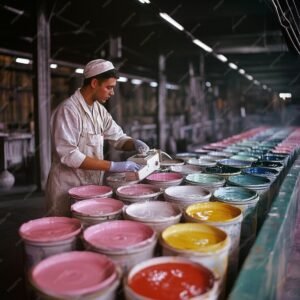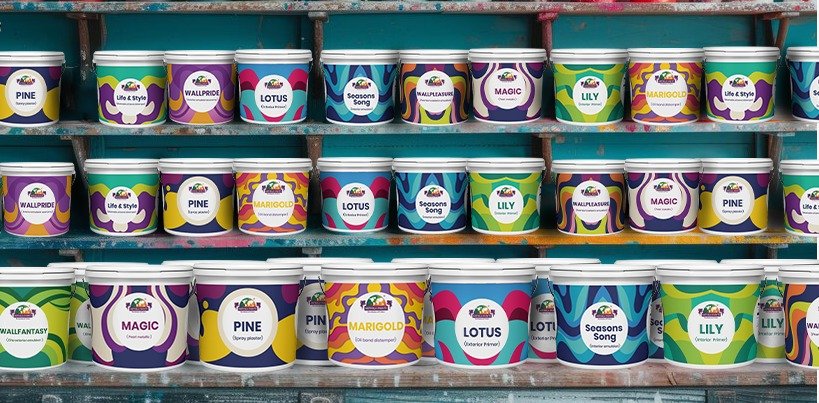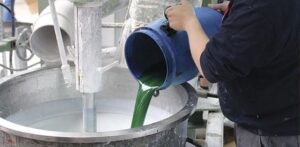Introduction to the Global Paint Manufacturing Market
The paint manufacturing market is a vital sector of the global economy, reflecting a wide array of applications and innovations. As industries continue to evolve, the demand for high-quality paint solutions has significantly increased. These products find application in various fields including construction, automotive, and consumer goods, contributing to the overall growth and diversification of the market.
In the construction industry, the need for protective and decorative coatings is paramount. Paint serves not only as an aesthetic enhancement but also provides necessary protection against various environmental factors. Different types of paints, such as those derived from mithila paints or other eco-friendly alternatives, are being adopted due to their durability and sustainability. This trend underscores the increasing consumer consciousness regarding environmental issues as well as the push for products that are less harmful to human health.
Within the automotive sector, paints and coatings are critical in enhancing vehicle appearance and longevity. The use of advanced technology in developing automotive paints that offer superior performance, such as resistance to scratches, UV radiation, and corrosion, has become more prevalent. Manufacturers are continuously focusing on creating innovative formulations, including catalyzed coatings and water-based finishes that align with global regulatory standards.
Moreover, the consumer goods sector has seen a marked increase in the use of specialized paints for decorative purposes. From functional applications to artistic endeavors, mithila paints and similar products cater to a niche market that values traditional craftsmanship alongside modern aesthetics. This aspect illustrates the intersection of cultural heritage and contemporary design, which enhances the appeal of various painted products across different demographics.
Overall, the paint manufacturing market is characterized by its versatility and immense significance across a multitude of industries. Understanding its dynamics is crucial for stakeholders aiming to navigate the complexities of this thriving sector.

Market Size and Growth Trends
The global paint manufacturing market has experienced significant growth in recent years, with a current valuation of approximately USD 200 billion as of 2023. The ongoing trends of urbanization and infrastructure development are propelling demand for various types of paints, including decorative and protective coatings. Notably, the growth trajectory is largely influenced by the increasing activities in the construction sector, which has seen a notable uptick due to both residential and commercial projects worldwide.
Mithila paints, alongside other eco-friendly alternatives, have been gaining traction in consumer markets as environmental awareness burgeons. Consumers are increasingly opting for products that not only meet aesthetic requirements but also contribute to sustainability goals. This shift in consumer preferences has led manufacturers to innovate and diversify their offerings, incorporating low-VOC (volatile organic compounds) and non-toxic ingredients into their formulations. As a result, the demand for these eco-friendly options is projected to enhance the overall market share of the paint industry.
Furthermore, according to industry reports, the global paint market is expected to grow at a compound annual growth rate (CAGR) of approximately 5% over the next five years. Key regions contributing to this growth include Asia-Pacific, North America, and Europe. Rapid urbanization and the rise in disposable incomes in developing countries, especially in Asia, are instrumental in expanding the consumer base for various paint products, including mithila paints. Additionally, governments are promoting the use of durable and sustainable materials in their housing initiatives, further boosting growth in the paint manufacturing sector.
In alignment with these trends, paint manufacturers are also focusing on technology advancements to enhance production capabilities and product quality, thereby responding effectively to the evolving market dynamics.

Key Players in the Paint Manufacturing Industry
The global paint manufacturing market is characterized by a diverse range of key players, each contributing to the industry’s growth and evolution through innovative products and strategic initiatives. Notable companies include AkzoNobel, PPG Industries, Sherwin-Williams, and RPM International, all of which have established a significant foothold within the market. These companies dominate through extensive distribution networks, robust research and development capabilities, and strong brand recognition.
AkzoNobel, for example, is one of the largest paint manufacturers in the world, with a wide array of decorative paints and performance coatings. Its focus on sustainability and eco-friendly products has positioned it favorably among environmentally conscious consumers, enhancing its market share. Similarly, PPG Industries has adopted a growth strategy that emphasizes innovation and technological advancements. The company’s investments in advanced measures to develop water-based and low-VOC paints have resonated well with shifting consumer preferences, particularly in residential applications.
Another important player is Sherwin-Williams, which not only provides architectural paints but also caters to the industrial and automotive coatings segments. The company has expanded through strategic acquisitions, bolstering its product offerings and diversifying its market presence. RPM International also plays a pivotal role, particularly in high-performance coatings and specialties. Its ability to address specific consumer needs and respond to varying market challenges signifies its competitive edge.
As these key players navigate ever-changing market dynamics, their strategies often include adapting to technological advancements, integrating digital transformation, and enhancing customer engagement. Furthermore, focusing on the specific segment of decorative paints, such as mithila paints, reflects how companies are evolving to meet niche market demands. Ultimately, the strategic efforts of these major companies shape the direction and future of the global paint manufacturing market.

Types of Paint Products
The paint manufacturing market offers a diverse array of products to cater to various applications and consumer preferences. Among these categories, water-based paints, solvent-based paints, and specialized coatings are prominent. Understanding the characteristics and applications of these different types is essential for both manufacturers and consumers in the market.
Water-based paints are distinguished by their use of water as the primary solvent. They are known for their low levels of volatile organic compounds (VOCs), making them a more environmentally friendly option. These paints dry quickly and can be easily cleaned with soap and water. Commonly used in residential and commercial interiors, water-based paints have gained popularity due to their versatility and ease of application. The surge in demand for green building materials has also bolstered the market for water-based products, including innovative options like mithila paints that celebrate cultural heritage while adhering to eco-friendly standards.
On the other hand, solvent-based paints contain organic solvents, which can provide a more durable finish compared to their water-based counterparts. These paints are particularly advantageous for outdoor applications due to their resilience against weather elements. However, they often have higher VOC levels, leading to environmental and health concerns. As a result, the market demand for solvent-based paints has become more scrutinized, pushing manufacturers to develop low-VOC alternatives to meet regulatory standards.
Lastly, specialized coatings encompass a wide range of products designed for specific applications, such as anti-corrosive paints, heat-resistant paints, and anti-bacterial coatings. These coatings cater to industries including construction, automotive, and manufacturing, where unique properties are required to withstand various environmental stresses. The increasing need for specialized solutions is driving innovation within the paint industry, expanding the offerings available to customers seeking tailored coatings that not only perform well but also resonate with evolving environmental guidelines.

Regional Analysis of the Paint Market
The global paint manufacturing market exhibits significant regional variances, influenced by factors such as economic growth, consumer preferences, and regulatory frameworks. In North America, the market benefits from a robust construction sector and increasing demand for environmentally friendly products. Here, manufacturers are focusing on innovations in mithila paints, which cater to aesthetic as well as sustainability needs. The shift towards eco-friendly and low-VOC (volatile organic compounds) formulations has positioned North America as a leader in the adoption of new technologies and sustainable practices in paint production.
Europe, similarly, is experiencing growth, characterized by a strong emphasis on sustainability and compliance with stringent environmental regulations. Countries like Germany and France are at the forefront of research and development in advanced coating technologies, impacting the production of mithila paints that adhere to quality and ecological standards. The ongoing expansion of the automotive and aerospace industries in this region also amplifies demand for specialized paint products.
As for the Asia-Pacific region, it presents the most significant growth potential for the paint manufacturing market. Rapid urbanization and increasing disposable income levels are driving demand for decorative and protective coatings. In countries such as India and China, traditional mithila paints are being blended with modern technology to create new products that appeal to younger consumers. However, challenges remain, notably in dealing with lower-quality imports and fluctuating raw material prices.
Latin America continues to recover from economic downturns, with projections of growth in construction and automotive sectors fueling opportunities for paint manufacturers. The Middle East & Africa face unique challenges; however, infrastructural investments and oil revenues are anticipated to spur growth in the paint market. The adoption of local variants of traditional mithila paints can serve as a competitive advantage, enabling manufacturers to cater to local tastes and preferences while fostering economic development.
Innovation and Technology in Paint Manufacturing
The paint manufacturing industry has experienced significant transformations owing to innovations in technology and advancements in chemical formulations. One of the prominent developments in recent years has been the emergence of environmentally friendly and sustainable paint products. Manufacturers are increasingly investing in the research and development of low-VOC (volatile organic compounds) and water-based paints, with Mithila paints often demonstrating exemplary formulations that adhere to stringent environmental standards. These innovations not only minimize harmful emissions but also cater to the growing consumer demand for sustainable home and industrial solutions.
Furthermore, the integration of advanced analytical techniques and digital technologies is revolutionizing the paint manufacturing process. Automation, encompassing robotics and smart machinery, is becoming an essential component of modern factories. These advancements facilitate enhanced precision in mixing, quality control, and packaging, resulting in a more efficient production flow. In particular, the implementation of automation in the production of Mithila paints has allowed for consistent quality, reduced operational costs, and minimized human error, thus driving competitiveness in the market.
Another noteworthy aspect is the role of technology in formulating specialty paints for specific applications. For example, developments in nano-coatings have resulted in paints that offer improved durability, resistance to weathering, and enhanced aesthetic appeal. These specialized formulations are increasingly popular across residential, commercial, and industrial sectors. Moreover, innovative waterborne and eco-friendly additives contribute to the overall performance of Mithila paints, showcasing the industry’s commitment to sustainability while meeting various functional requirements.
In conclusion, the interplay of innovation and technology is steering the future of the paint manufacturing sector. As companies continue to embrace advancements in formulations and automated processes, they not only enhance product quality but also address the urgent need for sustainable practices in the industry. This evolution signifies a promising trajectory for the global paint market, fostering growth and sustainability in a competitive landscape.

Challenges Facing the Paint Manufacturing Market
The global paint manufacturing market is currently navigating a complex landscape characterized by a multitude of challenges. Key among these issues are regulatory hurdles, environmental concerns, and stiff competition from alternative products. Stricter regulations imposed by governmental agencies regarding the volatile organic compounds (VOCs) in paints can significantly impact production processes. Manufacturers are required to invest in developing low-VOC and eco-friendly alternatives, which can lead to increased costs and longer product development cycles.
Environmental concerns also play a pivotal role in shaping the dynamics of the paint manufacturing sector. There is a growing awareness among consumers regarding the environmental impact of traditional paint products. This awareness has prompted a demand for sustainable options, such as water-based paints and other variations deemed more environmentally friendly. As a result, companies are increasingly challenged to innovate and adjust their formulations to meet both regulatory requirements and consumer expectations. The shift toward sustainability not only influences product development but also imposes complexities in sourcing raw materials.
Furthermore, the paint manufacturing market faces fierce competition from alternative products, such as wall coverings and finishes that do not require traditional paints. These alternatives often present easier application methods and variety in design, appealing particularly to a segment of consumers who prioritize convenience and aesthetics. Manufacturers of mithila paints, for example, find themselves in a position where they must emphasize the unique selling points of their products against the backdrop of these alternatives.
To navigate these challenges, businesses in the paint manufacturing industry must adopt strategic responses that include enhancing innovation, investing in research and development, and promoting the benefits of their specialized offerings. A holistic approach to addressing regulatory compliance and environmental stewardship will be crucial for maintaining market competitiveness and consumer trust in the evolving landscape of paint products.
Sustainability and Environmental Considerations
The global paint manufacturing market is increasingly embracing sustainability in response to heightened consumer demand for eco-friendly products. As awareness about environmental issues rises, consumers are gravitating towards paint options that minimize their ecological footprint. This shift has prompted paint manufacturers to innovate, leading to the development of various sustainable alternatives, such as water-based paints and those formulated with natural ingredients. Mithila paints, known for their commitment to sustainability, exemplify how traditional practices can be aligned with modern eco-friendly standards to create products that fulfill both aesthetic and environmental criteria.
Waste management is another critical area where paint manufacturers are focusing their sustainability efforts. Proper disposal and recycling of paint products are essential not only for mitigating environmental impact but also for complying with regulatory frameworks that govern hazardous materials. Companies are increasingly implementing take-back programs, allowing consumers to return leftover paint, which can then be repurposed or safely disposed of. Such initiatives not only reduce waste but also help educate consumers about responsible paint usage, reinforcing the importance of environmental stewardship in the industry.
Regulatory measures are evolving to further encourage sustainable practices across the paint manufacturing landscape. Agencies worldwide are establishing stricter guidelines to limit volatile organic compounds (VOCs) in paints, promoting the use of safer, low-emission alternatives. In response, manufacturers are reformulating their products to comply with these regulations. Mithila paints stands as a case study in this respect, successfully transitioning to lower VOC formulations without compromising on quality or performance. The adoption of such practices demonstrates the broader industry trend towards sustainability, highlighting how regulations and consumer preferences can drive substantial changes in manufacturing processes.
In conclusion, the integration of sustainability and environmental considerations within the paint manufacturing sector is not merely a trend but a necessary evolution driven by consumer demand and regulatory pressure. As manufacturers continue to innovate and adapt, the proliferation of eco-friendly options solidifies the industry’s commitment to a more sustainable future.
Future Outlook and Predictions
The global paint manufacturing market is poised for notable transformations in the coming years. As environmental awareness continues to rise, there is a marked shift towards sustainable and eco-friendly products. This trend is expected to significantly influence consumer preferences, promoting a higher demand for paints that are low in volatile organic compounds (VOCs) and made with natural ingredients. Mithila paints, originating from the Mithila region of India, exemplify this movement by combining traditional artistry with sustainability, appealing to environmentally conscious consumers and art enthusiasts alike.
Additionally, advancements in technology are likely to drive growth in the paint manufacturing sector. Innovations such as digitally manufactured paints and the use of artificial intelligence in production processes may enhance product quality and reduce costs. These technologies will also facilitate greater customization options for consumers, allowing for paints that match personal tastes and preferences more closely. The integration of smart technology in home painting solutions might further reshape the market landscape.
Moreover, regions undergoing rapid urbanization, especially in Asia and Africa, are anticipated to be significant growth sectors for the paint industry. As construction and renovation projects surge in these areas, the demand for vibrant, durable, and eco-friendly paints is expected to increase. Mithila paints could capitalize on this opportunity by promoting their rich cultural heritage and sustainable practices to tap into emerging markets.
However, potential global disruptions, such as supply chain challenges and economic fluctuations, may impact market stability. Stakeholders are advised to remain adaptable and innovative in navigating these challenges. Emphasizing resilience through diversification and understanding changing consumer preferences can lead to prosperous outcomes in the evolving landscape of the paint manufacturing market.

